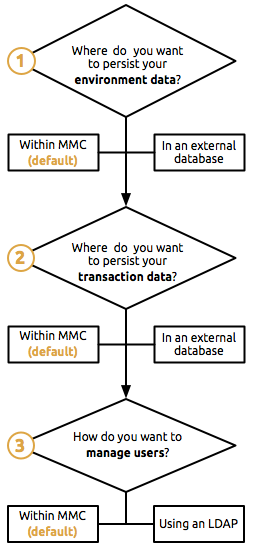
Setting Up MMC
| Mule Management Console (MMC) was deprecated in December 2015. Its End of Life is July 15, 2019. For more information see the MMC Migrator Tool or contact your Customer Success Manager to determine how you can migrate to Anypoint Runtime Manager. |
Overview
This document describes requisites, options and recommendations for setting up MMC in a production environment.
To set up MMC, you will first need to register your Mule ESB servers with MMC. For details on how to do this, see Setting Up MMC-Mule ESB Communications.
To use MMC in a production environment, you need to deploy MMC to a Web application server such as Tomcat. You do this when installing the production version of MMC.
The Setup Decisions below lists the default options as well as the alternate setup configurations that you can select when setting up MMC. By default, MMC stores environment or transaction data, as well as user and group information, in internal databases. Using alternate configurations, you can:
-
Set up external databases to persist MMC environment or transaction data (Business Events)
-
Manage MMC users and roles via LDAP
These options are covered in Setup Decisions in this document.
Assumptions
This document assumes you are an administrator account holder in MMC. It also assumes that you have installed:
-
Mule Enterprise 3.4.1 or later. Download it from the customer portal if you need to upgrade to this version.
-
MMC Version 3.4.1 or later. Download it from the customer portal if you need to upgrade to this version.
-
a Web application server such as Tcat, Tomcat, or JBoss. Please refer to the Hardware and Software Requirements for the latest information about hardware requirements and supported application servers, Java Runtime Environments, and browsers.
Recommended Environment Architecture
MuleSoft recommends using one instance of MMC per critical environment, and one for testing and QA. In a site with testing, staging and production environments, the recommended setup is:
-
1 instance of MMC to monitor and manage Dev, QA and Test environments
-
1 instance of MMC to monitor and manage the Staging environment
-
1 instance of MMC to monitor and manage the Production environment
Setup Decisions
Answer these three basic questions, then proceed with the setup steps, as needed.


By default, MMC persists environment data (such as created alerts, deployments, user data, etc.) within MMC on the same server as the Management Console application.
It is recommended that you set up an external database to persist your environment data to guard against data loss in case of a catastrophic failure.
See Data Persistence for links to supported databases and setup instructions.

By default, MMC persists transaction data (business events) within MMC on the same server as the Management Console application.
It is recommended that you set up an external database to persist your transaction data to serve as disaster-recovery backup and to improve performance.
See Data Persistence for links to supported databases and set up instructions.

MMC includes built in user-management capabilities that allow you to define user groups, assign fine-grained access controls to those groups, and add and manage users.
See Setting Up and Managing Users in MMC for more information.
If you have an existing LDAP database to manage user data such as usernames and passwords, you can configure MMC to connect directly to the LDAP server for user management. Note that you will still need to define user groups and permissions using the MMC interface.
See Setting Up and Managing Users via LDAP for more information.
Data Persistence
Out of the box, the Mule Management Console uses internal databases to store two different kinds of data:
-
Environment data (alerts, deployments, user data, etc.)
-
Transaction data (business events)
Since by default these databases reside on the same host as the Management Console, a catastrophic failure of the host would cause the loss of both environment and transaction data. You can avoid this situation by configuring the console to use external databases to store environment and transaction data. Following a catastrophic failure of the console host, you can set up the console on another server, then configure it to use the same databases as the previous instance.
|
Remember that environment data and transaction data must exist in two separate databases (regardless of whether they are on the same server or use the same platform). |
Externalizing information about Mule’s current state of operations can facilitate disaster recovery in two different types of scenarios:
-
Mule transaction-level failures: Failure to complete the obligatory sequence of message processing events for a single message.
-
Mule system-level failures: Failure of the entire Mule system.
You can externalize your data through JDBC to any supported database. Follow the links below for specific instructions for configuring the following databases to persist MMC environment and/or transaction data:
User Management
There are two ways of creating and configuring MMC user accounts:
To define user groups and assign fine-grained permissions to those groups, follow the instructions in Managing MMC Users and Roles. You can manage user groups and their permissions only through the MMC interface, even if you set up an LDAP server to manage user accounts.
See Also
-
Read more about Managing MMC Users and Roles.
-
Find out how to set up an Oracle, PostgreSQL, MySQL, or MS SQL Server database to persist your environment or transaction data.
-
Learn about the technical architecture of MMC.



